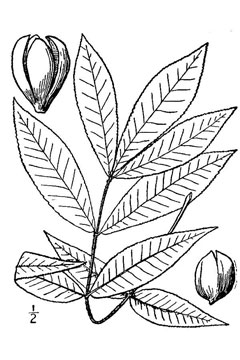
Black Hickory
Latin Name: Carya texana
USDA Hardiness: 5-9
Native Range: NORTHERN AMERICA: United States (Indiana (southwest), Illinois (south), Kansas (southeast), Missouri, Oklahoma, Arkansas, Louisiana, Mississippi (southwest), Texas)
Edibility Rating: 2 / 5
Medicinal Rating: 0 / 5
Region:
Family:
Plant Type:
Medicinal Uses
Edible Uses
Edible Parts: Seed | Edible Uses: Seed - raw or cooked[105, 177]. A sweet flavour, but the seed is small with a very thick shell[149, 227]. Another report says that the kernel has a bitter flavour[274]. The seed is up to 4cm long[229]. The seed ripens in late autumn and, when stored in its shell in a cool place, will keep for at least 6 months[K].
Cultivation
Prefers a deep moisture-retentive loam in a sunny sheltered position, requiring a good summer for best development[1, 63, 137, 200]. Slow growing[200]. There is some confusion over the naming of this species, with two separate authors of the name being cited. C. texana. Buckl. is used by some authorities as the correct name and C. buckleyi (q.v.) is given as a synonym of that species[11, 137]. However, other authorities cite C. texana. DC. as the correct name, in this case C. buckleyi remains as a separate species[82]. Plants are strongly tap-rooted and should be planted in their permanent positions as soon as possible[1, 137]. Sowing in situ would be the best method so long as the seed could be protected from mice[1, 200]. Trees are late coming into leaf (usually late May to June) and lose their leaves early in the autumn (usually in October)[137]. During this time they cast a heavy shade. These factors combine to make the trees eminently suitable for a mixed woodland planting with shrubs and other trees beneath them[137]. Plants in this genus are notably resistant to honey fungus[200]. Most species in this genus have quite a wide range of distribution and, in order to find trees more suited to this country, seed from the most appropriate provenances should be sought[137]. Most trees growing in Britain at present tend to only produce good seed after hot summers[137]. Trees are self-fertile but larger crops of better quality seeds are produced if cross-pollination takes place[229].
Known Hazards
None known
Habitats
Dry sandy woods or rocky slopes[43, 137]. Bottomlands and low wet woods[82]. Lowland and upland woods, usually on sandy soils but also sometimes on limestone[274].
